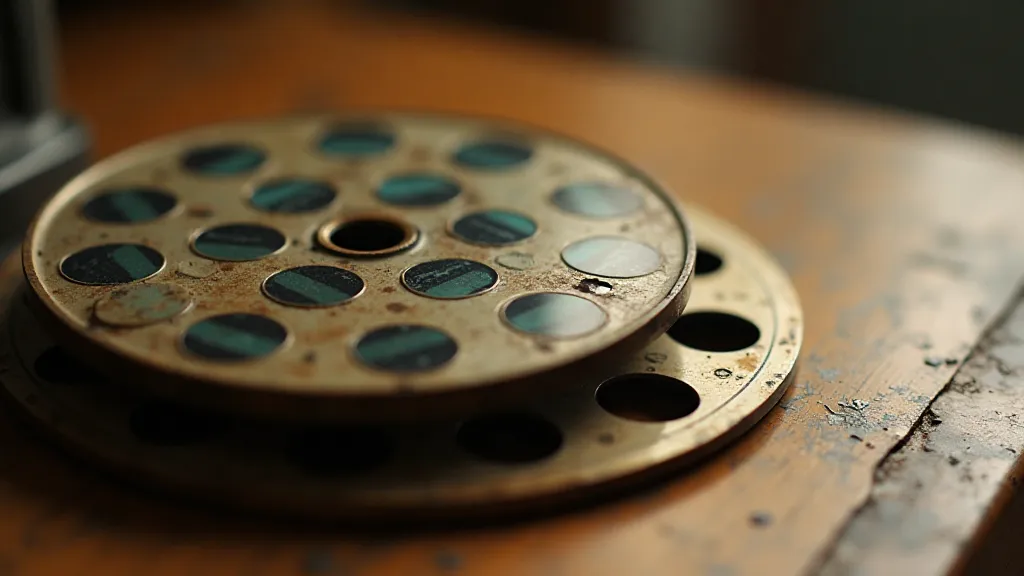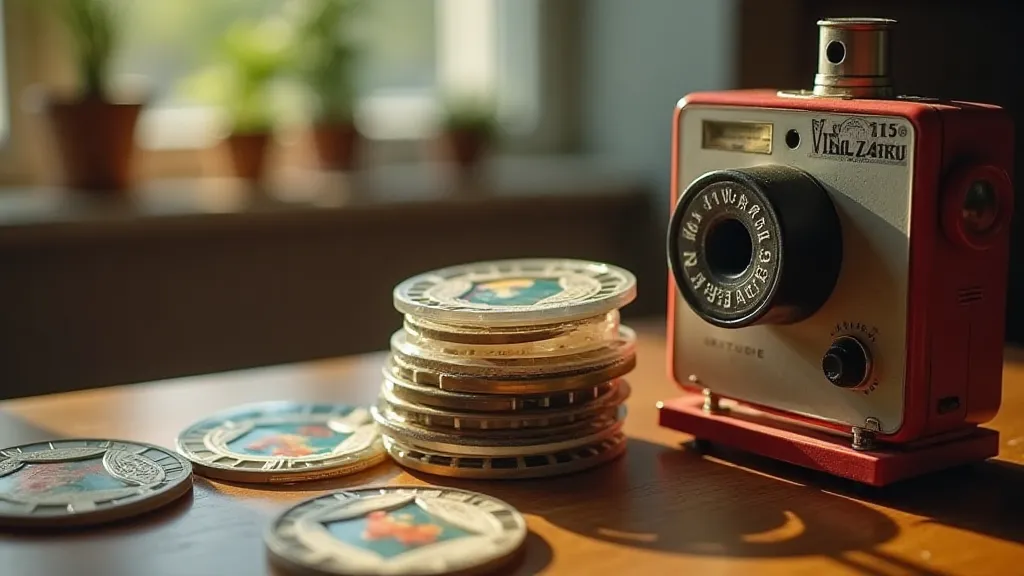Echoes in Plastic: The Materiality of View-Master Reels and the Changing Landscape of Consumerism
There's a peculiar intimacy in holding a vintage View-Master reel. It's not the tactile pleasure of polished wood or the reassuring heft of metal, but something else entirely – a lightness, a subtle fragility, and the palpable echo of countless childhoods. I remember finding a box of reels at a flea market years ago, a chaotic jumble of dusty cardboard and faded images. The scent alone transported me: a dry, slightly sweet aroma of aged cardboard and something vaguely chemical, a ghost of the manufacturing process itself. Holding those reels, turning them slowly, felt like stepping into a portal, not just to bygone destinations, but to a different era of consumerism and industrial production.
The View-Master, invented by Hans A. Feichtinger and later refined and popularized by Sawyer's View-Master Company, offered a window into a world then largely inaccessible to many. Imagine, in the mid-20th century, being able to "visit" the Grand Canyon, the Swiss Alps, or even the Taj Mahal, simply by clicking a lever and gazing through a viewer. The allure was undeniable, a democratization of travel for families struggling through the Depression and eager for post-war optimism. But the true story lies not just in the images themselves, but in the very materials that brought those images to life - and how those materials tell a profound story about shifting industrial practices.

The Evolution of Materials: From Celluloid to Acetate
Early View-Master reels weren't made of the familiar acetate plastic we associate with them today. Initially, they utilized celluloid, a relatively new material at the time, made from treated nitrocellulose. Celluloid held the promise of being a versatile and workable plastic, but it was also highly flammable and prone to degradation over time. This inherent instability is why many of the earliest reels are brittle, discolored, and require extremely careful handling. The characteristic “cracking” seen on some vintage reels isn’t just age; it’s the legacy of that early, less-refined process.
The transition to acetate, a less volatile and more durable material, occurred gradually throughout the 1930s and 1940s. While acetate offered significant improvements in stability, it wasn’t a perfect solution. Even acetate reels are susceptible to UV damage, leading to a yellowing or “foxing” effect that collectors often lament. This is a stark reminder of the continuous evolution of materials science, even in something as seemingly simple as a childhood toy. Considering the global scope of these travel reels and how they broadened perspectives, it's fascinating to see how material science played a role in making those experiences possible. It's a perspective worthy of further exploration— a detailed look at the global scope of View-Master travel reels is a rich journey into that evolution.
The Craftsmanship Behind the Image: A Laborious Process
It's easy to take the seemingly endless supply of images for granted. Each reel comprised 30 frames, and the process of creating those tiny photographic positives was remarkably laborious. The original images were often taken by professional photographers, commissioned by Sawyer's. These were then reduced, reversed, and carefully printed onto thin sheets of film. The process wasn’t automated; it involved skilled technicians meticulously handling fragile materials. The slight imperfections, the occasional speck of dust on a frame, aren’t errors – they’re testaments to the human touch involved in their creation.
Think about the sheer volume of reels produced over the decades. Millions upon millions of them circulated, each one a small, intricate artifact reflecting the tastes and aspirations of a generation. The fact that so many have survived, albeit in varying conditions, is a minor miracle of preservation. These reels didn's simply transport us to exotic locales; they were intricate narratives themselves, and deserve to be considered within the broader context of historical storytelling— exploring the tapestry of time and how these seemingly small objects weave together larger historical narratives is truly rewarding.
The Changing Landscape of Consumerism: From Novelty to Commodity
The View-Master’s success wasn’t solely about the novelty of “virtual travel.” It also reflects the broader shift in consumer culture that defined the mid-20th century. Post-war America experienced unprecedented economic growth, leading to increased disposable income and a burgeoning desire for leisure activities and material possessions. The View-Master perfectly captured this zeitgeist. It wasn’t just a toy; it was a symbol of aspiration, a window into a world of possibility.
The evolution of the View-Master itself mirrors this change. Early reels were often presented in beautifully illustrated boxes, treated as cherished possessions. Later, as production increased to meet demand, the packaging became more utilitarian, reflecting the rise of mass-market consumerism. The focus shifted from the experience itself to the sheer volume of products available. The way we remember and connect to the past, through objects and experiences, is intrinsically linked to how we interpret those historical moments— much like how a skilled cartographer might map memory, the cartographer's gaze reveals the intricate connections between objects, memory, and narrative.

Collecting and Preservation: Echoes in Our Hands
For collectors today, the allure of vintage View-Master reels isn’t just about owning a piece of childhood nostalgia. It's about preserving a tangible link to a different era, an era characterized by both optimism and industrial innovation. The condition of a reel significantly impacts its value. "Mint" or "Near Mint" reels, those showing minimal wear and tear, command a premium. Reels in poor condition, those with significant damage or discoloration, may still hold value for their rarity or historical significance.
Restoration, however, is a delicate process. While cleaning dust and debris is generally safe, attempting to repair damaged frames or restore color can easily devalue a reel. The best approach is often preservation – careful storage in a cool, dark environment to minimize further degradation. Handling reels with clean, white gloves is a simple precaution that can significantly extend their lifespan. Furthermore, appreciating these objects requires understanding not just their material composition, but also the stories they hold and the cultural context in which they were created. It's a deeper look at how images can capture and convey emotions and experiences – a closer inspection of chromatic echoes, revealing layers of meaning and interpretation.
More than just objects, these reels are repositories of memories, both personal and collective. They’re a reminder of a time when imagination and ingenuity were paramount, and when even the simplest toy could transport you to another world. Holding one in your hand, turning the lever, and seeing those tiny images flicker to life – it’s an experience that transcends time, a tangible connection to the echoes of the past.

Beyond the Image: The Material Legacy
The story of View-Master reels is, ultimately, a microcosm of broader industrial and cultural shifts. It's a story about the evolution of materials, the changing nature of consumerism, and the enduring power of imagination. These seemingly insignificant plastic discs offer a unique lens through which to examine the complexities of our past, and to appreciate the craftsmanship and innovation that shaped our world. As collectors, we’re not just preserving toys; we’re preserving fragments of history, echoes in plastic, that resonate with the enduring human desire to explore, to dream, and to connect. The fragility of the materials themselves serve as a poignant reminder of the passage of time and the ephemeral nature of even the most cherished possessions. It’s a material legacy that continues to inspire curiosity and awe, urging us to delve deeper into the stories they hold and the cultural significance they represent. Examining the nuances of those narratives, the subtle shifts in design and production, reveals the dynamic interplay between industry, culture, and consumer desire. It's a window into a world where imagination and innovation converged, creating a lasting testament to the human spirit. The study of material objects like these provides a tangible connection to the past, allowing us to understand not only the technological advancements of the time but also the values and aspirations of those who lived through it. They are more than just relics of a bygone era; they are living documents, whispering tales of childhood wonder, industrial ingenuity, and the enduring power of human connection. And within these echoes in plastic, we find a profound reflection of ourselves, our history, and our ongoing quest for meaning and understanding.





